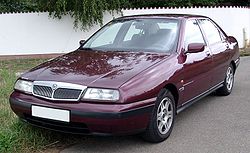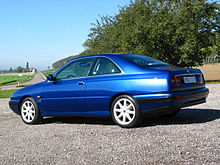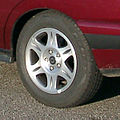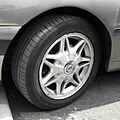Lancia Kappa
| Lancia | |
|---|---|
|
Lancia Kappa sedan (1994-1998)
|
|
| Kappa | |
| Production period: | 1994-2000 |
| Class : | upper middle class |
| Body versions : | Sedan , station wagon , coupé |
| Engines: |
Otto engines : 2.0–3.0 liters (107–162 kW) Diesel engines : 2.4 liters (91–100 kW) |
| Length: | 4565-4685 mm |
| Width: | 1825 mm |
| Height: | 1430-1460 mm |
| Wheelbase : | 2580-2700 mm |
| Empty weight : | 1425-1630 kg |
| Previous model | Lancia Thema |
| successor | Lancia Thesis |
The Lancia Kappa (or Lancia k ) was an upper middle class vehicle produced by the Italian automaker Lancia from summer 1994 to mid-2000 .
The vehicle was available as a four-door notchback sedan, five-door station wagon and two-door coupe. It bears the name of a historical model that was built from 1919 to 1922. Like many Lancia models, it was named after a letter from the ancient Greek alphabet.
history
The Kappa was the top model in the Lancia program as the successor to the Thema from August 1994 and came onto the market after a particularly long development period, which was intended to prevent all defects from the outset and ensure a high level of quality.
The spelling Lancia k was fixed and the Italian language Lancia Kappa in all languages .
The Kappa limousine was designed by the in-house design department Lancia Centro Stile in collaboration with the Turin-based design company IDEA. The car was set up on the platform called internally "D". In contrast to the organic design that was fashionable at the time, the shape appears more classic. The rear was dominated by the rear lights divided by the trunk lid, a flat rear window and a large bumper in the same color as the car.
The Kappa was powered either by a two-liter turbo four-cylinder (205 hp), a two-liter five-cylinder (145 hp), a 2.4-liter five-cylinder (175 hp), a three-liter V6 (204 hp) or a 2 , 4-liter turbodiesel with 124 hp. The two-liter version was available with either a short or a long gear ratio. In July 1996 the output of the 2.0 was increased to 155 hp. The Kappa SW 2.4 also featured the so-called PowerDrive transmission.
The equipment of the Kappa was extensive and included, among other things, a height and length adjustable steering wheel and a radio antenna integrated in the rear window, check control system, air conditioning (depending on the version), velor upholstery ( Alcantara or leather from Poltrona Frau on request), ABS , double airbag . There were three equipment variants at market launch: LE, LS and LX. The radio models of the first series were from Clarion and kept in the same design as the air conditioning controls. It was unusual for the time that people also thought about the smells of the plastics in the new car and installed an odor neutralizer in the form of a special cushion under the seat. The effect lasted half a year, as long as the plastics evaporate.
A version with an extended wheelbase, which included a two-part B-pillar with additional windows, was produced in five copies exclusively in the color dark brown, two of which had a vinyl roof and were used by the management of the Fiat group. Two of the other three examples still exist, all four vehicles are now in the hands of collectors, at least one of them in Switzerland. Each copy differs from the others in details.
Station wagon
Like its predecessor, the Thema SW, the station wagon version of the Kappa was designed and built by Pininfarina.
The Kappa SW was introduced in June 1996 and had a special feature of a matt anodized chrome strip on the roof edge, which in the area of the C-pillar followed the door cutout a little and at this point bore the Pininfarina logo that had designed the station wagon. In the Turbo models, the roof molding was anodized in dark gray matt and the door handles were painted in the same color as the body, as in the Coupé and Sedan.
9,193 copies of the Kappa Station Wagon were made.
Coupe
The Kappa Coupé was manufactured from January 1997 to March 2000 by the Italian bodywork company Maggiora .
The sedan and coupe are identical up to the A-pillar, the rest of the body has been redesigned. The rear window runs smoothly to the rear and is flanked by two indicated tail fins. They are supposed to be reminiscent of the design of the Lancia Flaminia Coupé from the 1960s.
The interior featured Recaro seating in Alcantara as standard . Leather upholstery from the Italian manufacturer Poltrona Frau , in which twelve color variants could be selected ("Kaleidos Leather"), could be ordered as an extra.
The Carrozzeria Maggiora in Chivasso produced a total of 3271 copies of the Kappa Coupé. It is one of the rarest mass-produced vehicles.
Facelift
In May 1998 the Kappa series underwent a slight revision. The most important innovation represented the two new engines: a two-liter five-cylinder petrol engine with turbocharger and an output of 220 hp and a 2.4 liter turbo diesel with common rail - direct injection , which made 136 hp. There were also side airbags and a radio navigation system from Blaupunkt (only in Germany) as standard.
Bumpers painted completely in the same color as the car, high-gloss imitation burl wood and a dashboard in an anthracite color made the vehicle look more modern and high-quality. New extras were cruise control and xenon headlights .
The "LE" variant was omitted, although aluminum rims, fog lights and Alcantara upholstery were still not standard in the basic version. New was the "Turbo Line" for the Turbo, which was characterized by dark anodized window frames, perforated Alcantara upholstery and door handles painted in the same color as the car.
equipment
There were accessories from the LineaAccessori program for the Lancia Kappa , such as roof racks , wooden gear knobs , adjustable dampers and the following rims:
- Lancia Kappa rims
Furthermore, the rims AZEV-B-Design , AZEV-C-Design and Borbet-D-Design were offered ex works , which were not kept in the Lancia design.
A parking aid called LOP was announced and presented, but it never went into production. With it the rear wheels were raised, and the car was rolled sideways into the parking space.
resonance
Production of the Kappa sedan and station wagon ended in July 2000. A total of 117,216 units of the Kappa were produced, of which 104,752 were in the sedan, 9,193 in the station wagon and 3,271 in the coupé. This means that the sedan was by far the most popular of the three variants, so that the station wagon only contributed 4% and the coupé only 2% to the sales success.
Its successor became from March 2002 the notchback sedan Lancia Thesis , whereby the Kappa SW and the Kappa Coupé remained without successors.
The limousine was government vehicle in Italy and Poland. In 2002, the Kappa was the most common vehicle used by Italian politicians, ahead of the Alfa Romeo 166 . Václav Havel privately drove a Kappa as a 2.0 16V from 1997 to 2006, after which the car went into a private collection. A prominent owner of a Kappa 3.0 in Germany was Joschka Fischer .
Giovanni Agnelli used an extended kappa (with inserted center piece) as a company car. The front seats were covered with blue leather, the rear seats with fabric, since Agnelli did not like leather seats. There were particularly large ashtrays on the rear doors.
Technical specifications
| 2.0 | 2.0 t | 2.4 | 3.0 | 2.4 td | 2.4 JTD | |||
|---|---|---|---|---|---|---|---|---|
| Construction period | 08 / 1994-06 / 1996 | 07 / 1996-07 / 2000 | 08 / 1994-05 / 1998 | 05 / 1998-07 / 2000 | 08 / 1994-07 / 2000 | 08 / 1994-05 / 1998 | 05 / 1998-07 / 2000 | |
| Engine characteristics | ||||||||
| Engine identification | 838A1000 | 838A6000 | 838A4000 | 175A3000 | 838A2000 | 838B000 | 838A7000 | 838A8000 |
| Engine type | R5 petrol engine | R4 petrol engine | R5 petrol engine | V6 petrol engine | R5 diesel engine | |||
| Number of valves per cylinder | 4th | 2 | ||||||
| Valve control | DOHC , timing belt | 2 × DOHC, toothed belt | OHC, timing belt | |||||
| Mixture preparation | Manifold injection |
Swirl chamber injection |
Common rail injection |
|||||
| Engine charging | - |
Turbocharger , intercooler |
- | Turbocharger, intercooler |
||||
| cooling | Water cooling | |||||||
| Bore × stroke | 82.00 mm x 75.65 mm | 84.00 mm x 90.00 mm | 82.00 mm x 75.65 mm | 83.00 mm x 90.40 mm | 93.00 mm x 72.60 mm | 82.00 mm x 90.40 mm | ||
| Displacement | 1998 cc | 1995 cc | 1998 cc | 2446 cc | 2959 cc | 2387 cc | ||
| Compression ratio | 10.0: 1 | 10.4: 1 | 8.0: 1 | 8.5: 1 | 10.0: 1 | 21.0: 1 | 18.45: 1 | |
| Max. Power at 1 / min |
107 kW (145 PS) / 6100 |
114 kW (155 PS) / 6500 |
151 kW (205 PS) / 5600 |
162 kW (220 PS) / 6000 |
129 kW (175 PS) / 6100 |
150 kW (204 PS) / 6300 |
91 kW (124 PS) / 4250 |
100 kW (136 PS) / 4250 |
| Max. Torque at 1 / min |
185 Nm / 4500 |
186 Nm / 4000 |
298 Nm / 2750 |
309 Nm / 2750 |
230 Nm / 3750 |
270 Nm / 4500 |
246 Nm / 2250 |
304 Nm / 2000 |
| Power transmission | ||||||||
| drive | Front wheel drive | |||||||
| Gearbox, as standard | 5-speed manual transmission | |||||||
| Gearbox, optional | 4- speed automatic transmission | - | 4-speed automatic transmission | - | ||||
| landing gear | ||||||||
| Front suspension | Wishbones, coil springs | |||||||
| Rear suspension | Wishbones, tension struts, coil springs | |||||||
| Brakes | Disc brakes all around (diameter f / h 28.1 / 27.6 cm), brake booster, ABS | |||||||
| steering | Rack and pinion steering, servo-assisted | |||||||
| Measured values (sedan) 1 | ||||||||
| Top speed | 205 km / h | 212 km / h (210 km / h) |
235 km / h | 243 km / h | 218 km / h (212 km / h) |
225 km / h (220 km / h) |
193 km / h | 202 km / h |
| Acceleration, 0-100 km / h | 9.8 s | 9.2 s (12.1 s) |
7.3 s | 8.7 s (10.5 s) |
8.0 s (9.8 s) |
10.7 s | 10.0 s | |
| Fuel consumption over 100 km (combined) | 9.4 l S | 8.5 l S (8.7 l S) |
9.0 l S | 8.1 l p | 9.4 l S | 9.8 l S (9.5 l S) |
8.4 l D | 7.7 l D. |
| Measured values (SW) 1 | ||||||||
| Top speed | - | 205 km / h | 230 km / h | 235 km / h | 212 km / h (206 km / h) |
218 km / h | 190 km / h | 200 km / h |
| Acceleration, 0-100 km / h | - | 10.0 s | 8.3 s | 7.7 s | 8.9 s (10.7 s) |
9.0 s | 11.5 s | 10.8 s |
| Fuel consumption over 100 km (combined) | - | 10.8 l S | 10.5 l S | 10.9 L S (11.6 L S) |
11.0 l S | 12.7 l p | 8.6 l D | 7.8 l D |
| Measured values (Coupé) 1 | ||||||||
| Top speed | - | 235 km / h | 243 km / h | 218 km / h | 220 km / h | - | ||
| Acceleration, 0-100 km / h | - | 7.3 s | 8.7 s | 9.8 s | - | |||
| Fuel consumption over 100 km (combined) | - | k. A. | 10.7 l p | (12.3 l S) | - | |||
- The availability of the engines depended on the model, equipment and market.
Trivia
- Strictly speaking, the spelling of the Greek lowercase letter Kappa is κ and not k . The sedan and station wagon are listed as k in internal documents , the Kappa Coupé as kC . However, the nameplate on the fenders says k .
literature
- Automobile revue. Catalog 1996, 1997 and 2000.
- Lancia Kappa owner's manual. Fiat Auto SpA, October 1994. Document No. 603.06.652.
- AutoKatalog model years 1995 to 2001
Web links
Individual evidence
- ↑ Paul Schinhofen: Lancia - Innovation and fascination; 100 eventful years. Heel Verlag, Königswinter 2006. ISBN 978-3-89880-649-7 . Pp. 112-115.
- ↑ Stephan Gebhardt-Seele: Forget everything about selling . P. 54
- ↑ Capital , edition 34/1995, p. 41
- ↑ Hans Knoblich , Bernd Schubert: Marketing with fragrance . P. 78
- ↑ Lancia - Innovation and Fascination: 100 Eventful Years, pp. 112/113/115
- ↑ Lancia - Innovation and Fascination: 100 Eventful Years, pp. 112/113/115
- ↑ lancia-historie.de (PDF)
- ↑ Note. In: Berliner Zeitung , June 6, 1998
- ↑ Autocar 2002 . Haymarket Motoring Pub.
- ↑ auto.idnes.cz
- ↑ Note. In: Berliner Zeitung , July 11, 1998
| Timeline of Lancia and Autobianchi models since 1945 | ||||||||||||||||||||||||||||||||||||||||||||||||||||||||||||||||||||||||||||
|---|---|---|---|---|---|---|---|---|---|---|---|---|---|---|---|---|---|---|---|---|---|---|---|---|---|---|---|---|---|---|---|---|---|---|---|---|---|---|---|---|---|---|---|---|---|---|---|---|---|---|---|---|---|---|---|---|---|---|---|---|---|---|---|---|---|---|---|---|---|---|---|---|---|---|---|---|
| Type | Lancia, independent until 1969 | Purchased by Fiat in 1969, Fiat number range since then | ||||||||||||||||||||||||||||||||||||||||||||||||||||||||||||||||||||||||||
| Autobianchi, JV between Bianchi, Fiat and Pirelli | from 1967 100% part of the Fiat group | abroad as Lancia, in Italy as Autobianchi | ||||||||||||||||||||||||||||||||||||||||||||||||||||||||||||||||||||||||||
| 1940s | 1950s | 1960s | 1970s | 1980s | 1990s | 2000s | 2010s | 2020s | ||||||||||||||||||||||||||||||||||||||||||||||||||||||||||||||||||||
| 5 | 6th | 7th | 8th | 9 | 0 | 1 | 2 | 3 | 4th | 5 | 6th | 7th | 8th | 9 | 0 | 1 | 2 | 3 | 4th | 5 | 6th | 7th | 8th | 9 | 0 | 1 | 2 | 3 | 4th | 5 | 6th | 7th | 8th | 9 | 0 | 1 | 2 | 3 | 4th | 5 | 6th | 7th | 8th | 9 | 0 | 1 | 2 | 3 | 4th | 5 | 6th | 7th | 8th | 9 | 0 | 1 | 2 | 3 | 4th | 5 | 6th | 7th | 8th | 9 | 0 | 1 | 2 | 3 | 4th | 5 | 6th | 7th | 8th | 9 | 0 | |
| Microcar | Bianchina | Giardiniera | ||||||||||||||||||||||||||||||||||||||||||||||||||||||||||||||||||||||||||
| Small car | A112 | Y10 (156) | Y (840) | Ypsilon (843) | Ypsilon (846) | |||||||||||||||||||||||||||||||||||||||||||||||||||||||||||||||||||||||
| Compact class | A111 | Delta I [2] (831) | Delta II (836) | Delta III (844) | ||||||||||||||||||||||||||||||||||||||||||||||||||||||||||||||||||||||||
| Middle class | Primula | Prism (831) | Dedra (835) | Lybra (839) | ||||||||||||||||||||||||||||||||||||||||||||||||||||||||||||||||||||||||
| ... Ardea | Appia | Fulvia | Beta / Trevi (828) | Flavia | ||||||||||||||||||||||||||||||||||||||||||||||||||||||||||||||||||||||||
| upper middle class | Flavia | 2000 | Gamma (830) | Theme (834 / Y9) | Kappa (838) | Thesis (841) | theme | |||||||||||||||||||||||||||||||||||||||||||||||||||||||||||||||||||||
| Coupé / convertible | Stellina | |||||||||||||||||||||||||||||||||||||||||||||||||||||||||||||||||||||||||||
| Fulvia Coupé / Sport | Beta Coupé [1] / Spider / Montecarlo (828) | |||||||||||||||||||||||||||||||||||||||||||||||||||||||||||||||||||||||||||
| Aurelia | Flaminia | Gamma Coupé / GT (830) |
Kappa Coupé (838) |
|||||||||||||||||||||||||||||||||||||||||||||||||||||||||||||||||||||||||
| Sports car | Stratos | |||||||||||||||||||||||||||||||||||||||||||||||||||||||||||||||||||||||||||
| Minivan | Musa (350) | |||||||||||||||||||||||||||||||||||||||||||||||||||||||||||||||||||||||||||
| Van | Zeta (220) | Phedra (179) | Voyager | |||||||||||||||||||||||||||||||||||||||||||||||||||||||||||||||||||||||||
|
[1] also built by Seat in Spain |
||||||||||||||||||||||||||||||||||||||||||||||||||||||||||||||||||||||||||||











